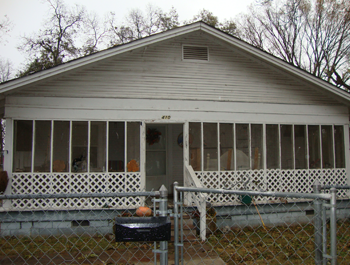Image

Kimberly Miller, Executive Director, Universal Housing Development Corporation
Challenge: For more than a decade, the lack of affordable housing has been one of the biggest challenges in Arkansas, one of the poorest states in the nation. The housing stock is among the oldest and many of the houses are dilapidated and pose serious health threats.
Arkansas is one of the poorest states in the nation and affordable housing is one of its biggest challenges. Many homes are old and rundown, posing serious health and safety risks. This is especially the case for the elderly, the poor and people with disabilities. These residents may own their homes outright, but their houses no longer provide suitable shelter because they cannot cover the necessary repairs or the cost of moving to better housing. While they may have family or friends who could help them rehabilitate their homes, they still lack the funds for materials and assistance in getting the job done. These homeowners may have realized the American Dream of homeownership, but they risk losing that home if they can't make it livable.
Since 1971, Universal Housing Development Corporation (UHDC) has helped residents in the Arkansas River Valley build their own homes. Our Mutual Self-Help Housing Program allows clients or volunteers to contribute labor for the construction, for which we provide supervision. But that doesn't help those who already own homes that are falling into disrepair and may jeopardize their health and security. Their urgent need prompted UHDC in 2012 to extend our "sweat-equity" approach to home rehabilitation.
Our Self-Help Home Rehabilitation program has homeowners or volunteers provide the labor for repairing their homes, and the savings on labor allows more work to be completed on the project. Sometimes when a needed repair such as a leaking roof has been deferred for years, the scope of the work can grow to include damaged or collapsed ceilings, walls stained with mold or mildew and weakened floors. In such cases, limited funding can make it nearly impossible to do everything that needs to be done. Using contributed labor changes that, making it possible to breathe life into a dream of homeownership that was slowly dying. Tasks that require professional licenses such as plumbing and electrical work are still completed by contractors, but the homeowners are able to get more of the necessary work completed by doing other tasks under the guidance of UHDC's supervisors. This ensures that all the work is completed to the highest standard and that low-income residents can safely stay in the affordable homes they already own.
In one of our projects, Brent Christy and his family lived in a home built in 1938 that was falling into serious disrepair. His Rural Development Housing Preservation Grant (HPG) would only cover a new roof, not the other urgently needed repairs. His bathroom tub leaked, all of his windows were single-paned aluminum that leaked air badly. His exterior doors were hollow core, which is useless for stopping heat from escaping in the winter -- or anyone from breaking in. The hall floors were weak and there was little or no insulation, the wooden siding was rotting and the electrical system wasn't up to code. The gas stove was also leaking and the hot water heater needed to be replaced. We got assistance for some of the work through the Federal Home Loan Bank of Dallas Special Needs Assistance Program (SNAP), but those funds wouldn't have made a dent in the rest of the work needed without Christy's contributed labor.
 Christy installed the windows and doors provided by SNAP himself with coaching from a UHDC construction supervisor. Christy was supposed to prep the bathroom for the plumber as well, but there was a breakdown in communication and Christy ended up taking the entire bathroom down to the stud walls! There was enough left in the HPG to buy the materials for Christy to replace the walls and to have a plumber reinstall the toilet and vanity. The Rural Initiative for the NeighborWorks-Wells Fargo Safe and Sound program provided funding for the rest of the work.
Christy installed the windows and doors provided by SNAP himself with coaching from a UHDC construction supervisor. Christy was supposed to prep the bathroom for the plumber as well, but there was a breakdown in communication and Christy ended up taking the entire bathroom down to the stud walls! There was enough left in the HPG to buy the materials for Christy to replace the walls and to have a plumber reinstall the toilet and vanity. The Rural Initiative for the NeighborWorks-Wells Fargo Safe and Sound program provided funding for the rest of the work.Christy's aging home is now as energy-efficient as a new one, and it is structurally solid enough to last as long. It took funds from three different programs and a lot of hard work, but Christy and his family are living in a decent, affordable home that makes the whole neighborhood proud.
Since December of 2012, UHDC has preserved 52 homes for low and very-low income homeowners through our Self-Help Home Rehabilitation program. The contributed labor has resulted in a total savings of over $274,400 in project costs for these homes. Homeowners have also learned valuable skills that enable them to make future repairs. Often they don't stop at just the health and safety improvements we can fund, and the results are often a more dramatic improvement in living conditions than we had anticipated.
Our motto, "Helping People, Building Dreams," now extends beyond our original mission to make homeownership more than a dream for our residents. We can now help those in need to hang on to their homes and age in place safely and securely. Since launching our Self-Help Rehabilitation program, we have learned three simple keys to success: communication, coaching, and coordinated funding.

